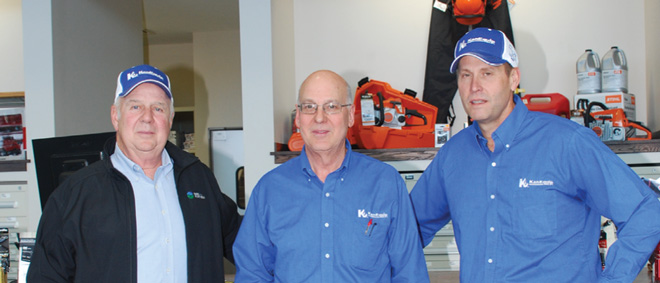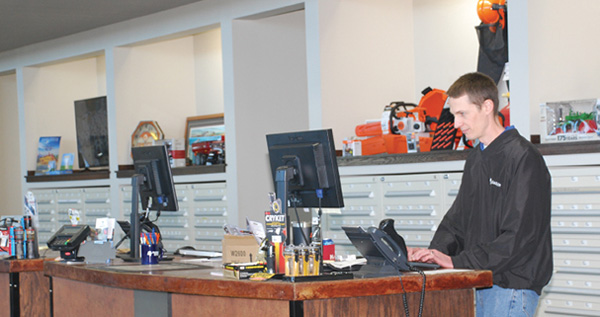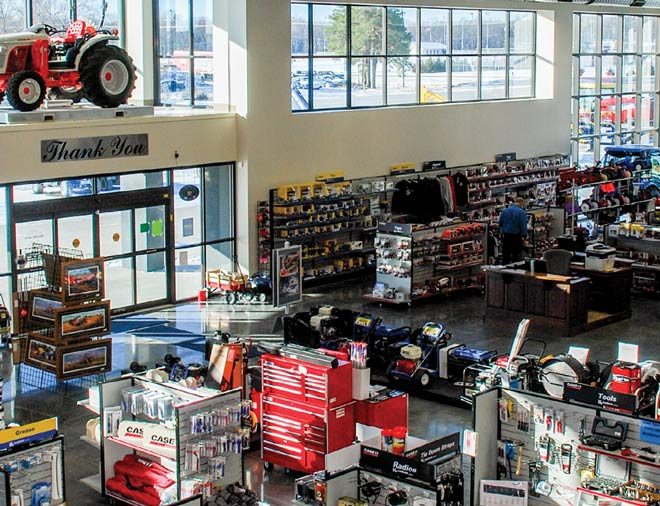Pictured Above: KanEquip’s renovation of its Wamego, Kan., headquarters included a significant expansion of its retail space. The dealership can now showcase a comprehensive inventory of equipment, tools, supplies, toys and more. The staff changes the arrangement of the displays about every quarter.
KanEquip
Founded: 1967 Locations: 8 Kansas locations (Clay Center, Dodge City, Garden City, Ellsworth, Topeka, Marysville, Wamego and Herington) as well as Syracuse, Neb. Employees: 157 Lines: New Holland, Kubota, Case IH, Land Pride, Grasshopper, Honda Power Equipment, Alkota and Stihl Business System: Basic Software Systems
KanEquip has faced changes head on throughout its 50-year history, whether it be acquisitions, a weak farm economy or a recent $6 million renovation of its Wamego, Kan., headquarters.
They also tuned in early to the rural lifestyle market. “If we were strictly a farm equipment dealership today, I think we’d be in trouble,” says Jim Meinhardt, a company owner. The dealership has 9 locations in northern and western Kansas and Nebraska. It carries New Holland, Kubota, Case IH, Land Pride, Grasshopper, Honda Power Equipment, Stihl, Alkota and other lines.
Meinhardt is part of the generation of dealers who grew up in the business. “I grew up sweeping floors and finding parts along with farming and ranching with my dad. I went from a grunt and hired man to store manager and owner,” he says.
His dad, Eddie, started as an Allis Chalmers dealer in Paxico, Kan., in the 1950s. A dealership came up for sale in 1967 in Wamego, Kan. Eddie bought the dealership and Meinhardt took over as manager of Meinhardt Farm Equipment at the age of 19.
Growing the Dealership
The dealership added the New Holland line in 1967. “To be real frank, I was flying blind. We put up hay on our farm and I always used New Holland equipment and had good luck with it and so it was easy to sell New Holland equipment,” Meinhardt says.
Dealer Takeaways
• Don’t settle for facilities that are too small, inefficient or detract from your ability to sell.
• Get buy-in from your team when taking on a major remodeling project so you are sure to help them do their jobs better.
• An attractive retail space enhances the customer experience and may spur purchases.
• Consider programs that allow managers or employees to invest in the dealership.
The dealership’s growth has come through a series of acquisitions, many of which presented themselves because the dealer principals wanted to retire, or through other opportunities, such as their purchase of their Herington, Kan., location. “In the early 1980s when the farm economy was terrible, the dealership in Herington closed. The bank owned the building and was trying to sell it to me. One day I made a ridiculous offer and he took it,” Meinhardt says.
A major step in their growth was the merger with Ford County Equipment, based in Dodge City, Kan., in 1999, at a time when New Holland was pushing for larger dealership groups. “This merger gave us a little bit of everything we were looking for and a chance to merge with a stable dealership. It provided opportunities in purchasing of parts and supplies — volume discounts were a big deal back then,” Meinhardt says.
The dealership’s reach stretches diagonally across Kansas, from the northeast corner of the state to the southwestern border as well as southeastern Nebraska.

Jim Meinhardt (left) is a co-owner of KanEquip. Doug Meinhardt (center) is parts director and Mark Besthorn (right) is store manager of KanEquip’s Wamego location. They gathered input from the entire team for a $6 million renovation.
Adding New Focus
The dealership has always carried lower horsepower tractors, but their major lines, Case IH and New Holland, placed less emphasis on the category over the years, says Meinhardt. They began carrying Kubota in 2002 to expand their compact tractor lineup and to serve the growing rural lifestyle market in their territory.
“There weren’t a lot of dealerships at that time between here and Kansas City that were carrying the smaller tractors. We started growing our rural lifestyle business with compact tractors and added RTVs and zero-turn mowers. Our Kubota sales continue to grow year over year,” says Mark Besthorn, store manager for the Wamego location. He adds, “We’ve always been big in hay and forage and cash grain and we’re hoping the consumer products division is going to stabilize our revenue stream.”
The Wamego location covers the cities of Topeka (the state capitol), Manhattan (home of Kansas State University) as well as the Kansas City area, the state’s largest metro region. The dealership is also hoping to gain customers from a new employer, the National Bio and Agro-Defense Facility, which will open in Manhattan in the next few years. “This will bring good paying jobs as well as generate jobs from supporting companies,” Besthorn says.
KanEquip has been carrying other rural and consumer lines for quite some time. They added Grasshopper in the 1980s and Walker Mowers in 1997 and have been carrying Land Pride equipment since the early days of the dealership. Land Pride’s parent company, Great Plains Mfg., is based less than 100 miles from Wamego. “We work closely with Land Pride and have tested a lot of their equipment. We were the first dealership to earn $1 million in annual sales of Land Pride equipment,” says Besthorn. That was about 7 years ago and sales have been steady since then.
Deciding to Renovate
The original Wamego facility was about 5,000 square feet and to meet the growing market, buildings were added over the years. Still, the facilities, especially the shop, weren’t providing what the growing dealership needed. In 2014, Meinhardt and the leadership team decided to make a major investment in its future.
Creating Space, Efficiencies in the Parts Department
KanEquip’s remodeling of its headquarters facility in Wamego, Kan. — a $6 million investment — included a significant upgrade to its parts department. The dealership had already been using 12 Stanley Vidmar industrial storage cabinets and purchased 24 more. They also added Western Pacific shelving in the parts warehouse and did an overall remodeling of its parts counter.
Jeff Spradlin, Stanley Vidmar territory sales manager, says KanEquip follows best practices related to parts. “They have a lot of parts that are close to the counter and that are readily available to the customer. They have long counters, so the parts staff has enough space and they’re not impeding on each other’s conversations,” he says. “The counter arrangement also accomplished a ‘separation barrier,’ which keeps customers from coming around to look at the monitors. What they did rings loudly in the dealership’s surrounding environment.”
Spradlin offers this advice to other dealers who may be considering a parts department upgrade. “When it comes to storage, you want to think in terms of how much inventory you can keep on hand, how quickly you can locate the parts and how fast can you get to them.
“The typical scenario we see when we start working with a dealership is a general disarray of boxes and items everywhere, thinking a part is located on one shelf and you find it three shelves over. Thinking they had seven of a part in stock when they actually had two or thinking they had two when they actually had seven and then they ordered 10 more,” he says.
Spradlin says a dealer may delay improving their parts department because of concerns about the investment; finding the time to make the transition; and a general disbelief in what a new storage system can bring to a dealership. He offers these questions to help dealers decide:
- Return on Investment: How many “picks” are your parts department employees making each day and how much time could be saved? Improvements could increase the value of your investment in each employee and their contribution to the dealership’s profitability.
- Inventory control: A more controlled parts inventory could mean that you could reduce the amount of inventory you carry.
- Competitive advantage: A more efficient parts department could mean that customers choose you because they can rely on you to have the right parts or that you serve them better.
Spradlin also says that upgrades aren’t limited to large dealerships. “I never look at it from a revenue perspective. Look at your available space and number of fast-moving parts. You want to have 100-200 of the fast-moving parts closest to the counter. You want to achieve a consistent flow of customers,” he says.
“One of the buildings had roof problems and our display area could only show one lawn mower. We also wanted to offer toys and clothes and other things that people need when they come in to buy equipment. We needed to add retail space — we needed something to draw the people in. We wanted to create a good and clean customer environment,” Meinhardt says.
Their shop space was also lacking as the area was designed for equipment much smaller than today’s massive farm equipment. Service techs were bumping against the ceiling when working on combines, for instance.
“We had expanded from 8 to 13 service techs and we just ran out of space. We were also storing parts in 4 different locations,” says Mark Besthorn, store manager.
They called upon those service techs and others for input on how the new dealership should look. “We wanted to get the mechanics’ buy-in, so we went to them and said, ‘Tell us what you need, so we can build the shop you want. Don’t come complaining to us later,”’ Meinhardt says.
Besthorn says he and several others traveled almost 2,000 miles over the course of 3 days to see the facilities of other progressive dealers. They turned to local contractor Carley Construction for the design and build.
They started construction in October 2015 and completed in August of 2016. Throughout that time, the sales and parts teams made do in temporary work spaces as various parts of construction were completed. For instance, conference rooms became sales offices and the new indoor showroom for large equipment was the temporary parts department.
They scrapped most of their existing footprint, saving only the old 120-foot x 150-foot shop to use as a parts warehouse and expanding from there. The new 71,000 square-foot facility has a 200-foot x 200-foot shop. Its new showroom, retail space, parts counters and sales and service offices measure 80 feet x 100 feet.
Improving Parts Efficiencies
A major goal of the remodel was to improve the parts department, moving away from wooden bins and dark hallways to reduce the amount of time it takes the parts staff to serve customers.
They had already been using 12 Stanley Vidmar industrial storage cabinets and expanded that to 36 units in the new parts areas. Fast-moving parts are located behind the counter and other frequently requested parts are in a nearby room, which leads into the parts warehouse. The parts warehouse has Western Pacific shelving, which features slotted floors, allowing light to shine through. Most of the shelving units are 8.5 feet high and have 6-9 adjustable shelves. KanEquip worked with its Stanley Vidmar representative to design and purchase the shelving.
“We have a fairly close relationship with Stanley Vidmar and we have their storage cabinets at all of our locations. They looked at our building plans and our parts inventory and came up with a determination of what parts could be stored in the high-density cabinets vs. the shelving units,” Besthorn says. (See sidebar, “Creating Space, Efficiencies in the Parts Department.”)
“Our parts are now in a clean, climate-controlled environment and are in a much better condition when we deliver them to the customer. We’re also able to keep on top of inventory and have a more accurate count at the end of the year,” Besthorn says.
Meinhardt says, “The cabinets were expensive, but are worth it. They save trips and are clean. The key to surviving in this business is parts and service.”
The team built for expansion as well, with the parts counter having enough space to add three more people to the parts staff. The Wamego location’s parts team includes a parts director, Doug Meinhardt (Jim’s brother), three full-time parts salespeople, a part-time person who handles orders for the other locations and oversees the warehouse, and a part-time person who handles shipping and receiving. Because they handle parts orders for the other 8 locations, their efficiency affects parts revenue across the dealership group.
The parts team dedicated a week to transitioning all the parts from their temporary locations to their new locations in the cabinets or on the shelving, with Doug Meinhardt entering location data in their Basic Software Systems dealership management system.

The dealership’s renovation included an investment in its parts storage facilities. The dealership now has 36 Stanley Vidmar industrial storage cabinets in the parts area as well as Western Pacific shelving in the parts warehouse. Shown is Travis Hageman, KanEquip’s parts manager.
Enhancing Retail Experience
KanEquip’s new retail space and indoor showroom were designed to provide a comfortable shopping experience, ample space for displaying equipment as well as a full assortment of items that rural lifestylers and others need.
“We wanted to diversify our retail offerings — expanding what we had been carrying and offer totally new products, such as tool boxes, commercial pressure washers and tools. We sent the design team at CNH our floorplan and they helped us figure out our displays,” says Besthorn.
Customers enter through large automatic doors and are greeted by a receptionist or the dedicated indoor salesperson. Straight ahead is the parts counter, with the sales and service manager offices also visible. Equipment is displayed on each end, with space to accommodate large equipment, such as a combine, compact tractor, utility vehicles, mowers or even a telehandler. The center retail space features tools, supplies, clothing, toys, generators, pressure washers and a large Stihl display. There is even a refreshment area.
Signs are placed above each display area and the displays are all kept to 4 or 4.5 feet so customers can see around the store — and so the team can see the customers.
“We have a receptionist that greets everybody as they come in the door. If they’re looking for someone, she can help find them. Our service and parts desks have big windows or are open so employees can see who is coming in,” says Besthorn. “All our retail shelving has wheels so we can easily rearrange the retail space. We average a complete showroom swap about every quarter.”
Measuring Results
The new facility is performing as the team hoped it would. The dealership is more attractive from the road and the retail space is generating more traffic. The parts department serves customers better and the new shop has increased service revenue and provided space for a service tech to focus on compact equipment repairs. “It’s a phenomenal facility and I don’t think we went overboard,” says Besthorn.
The challenge with measuring results is the expansion happened during the downturn in the ag market. “We really started working on the shop in 2014 and June is when the ag cycle started its downturn, so it’s hard to say because our gross sales are down compared to what they were a few years ago,” says Besthorn.
Planning Succession
In addition to its infrastructure investments, KanEquip is securing its future through a succession plan. Meinhardt says that he and the original dealer principals from the mergers, Jim Burke and Terry Robl, are in their 70s. “We asked ourselves, ‘What are we going to do with this monster?’ We have good young managers in place who can take this business over,” he says. The management team also includes his sons, Bryndon and Grant, and daughter, Jaimee.
“When we did the merger, we set a beginning value on our assets. We used that valuation to set up a stock ownership plan,” Meinhardt says. They have a limited number of shares and no one outside the company is an investor. If an employee who holds stock leaves the company, they have to sell their shares back to the company or to another employee.
Meinhardt says the program has worked well. “At this point, we have 3 major stockholders and the younger generation is slowly starting to invest,” he says.
Big steps like the remodel and the succession plan help drive the future but the dealership remains focused on customer service. “One of my biggest fights during the remodel was to keep a receptionist at the door. It’s important that we welcome people and we thank them,”Meinhardt says.






Post a comment
Report Abusive Comment